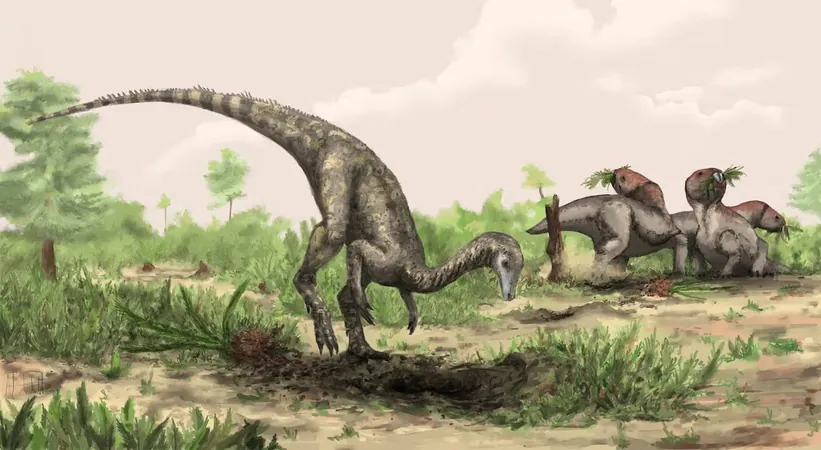
Unveiling the Origins: Where Did Dinosaurs First Evolve?
2025-01-24
Author: Yu
Introduction
For decades, the mysterious origins of dinosaurs have captivated scientists and enthusiasts alike. From the giant herbivores like Argentinosaurus to the fearsome hunter Tyrannosaurus rex, these ancient reptiles once ruled the land. But the exact timeline and geographical origin of dinosaurs continue to baffle researchers. Recent studies suggest a surprising answer that could reshape our understanding of these prehistoric giants.
Proposed Origins of Dinosaurs
New findings propose that the elusive birthplace of dinosaurs may lie in a region that today spans the Sahara Desert and the Amazon Rainforest. According to a study published in Current Biology, researchers linked fossil discovery sites with Earth's ancient geography during the Triassic Period to suggest that the first dinosaurs arose near the equator within the supercontinent Pangaea, specifically in a landmass called Gondwana.
Lead author Joel Heath, a paleontology doctoral student at University College London and the Natural History Museum, emphasized the significance of this research: “Our findings indicate that dinosaurs likely emerged in low-latitude areas of Gondwana, encompassing parts of modern-day northern South America and northern Africa.”
The Oldest Dinosaur Fossils
The oldest-known dinosaur fossils date back approximately 230 million years, showcasing early species like Eoraptor, Herrerasaurus, and Saturnalia. While these creatures exhibit traits that classify them as dinosaurs, their variances indicate that a considerable evolutionary journey had already taken place before their fossils were formed.
Challenges in Fossil Discovery
Interestingly, Heath noted that while prior research pointed to southern South America and Africa as the cradle of dinosaur evolution, significant gaps in the fossil record—particularly in today's Sahara and Amazon—might hold further clues about their origins. “These regions were likely home to early dinosaurs, even though we haven’t yet uncovered their fossils,” he stated.
Understanding the environments that existed during this time is crucial. The researchers believe dinosaurs developed during a period characterized by extreme heat and dryness, possibly featuring deserts and savannah-like regions, alongside occasional forested areas with seasonal wildfires. This contradicts earlier notions that dinosaurs thrived only in lush environments.
Scarcity of Fossils
However, fossils from the Triassic Period are scarce. Heath explains that the preservation conditions might not have favored the survival of dinosaur remains or that the necessary geological layers remain undiscovered. Moreover, dense forests and vast deserts pose significant challenges for paleontologists attempting to traverse these terrains.
Evolutionary Journey of Dinosaurs
Dinosaurs are believed to have evolved from more primitive reptiles during a tumultuous period marked by the end of the Permian extinction, which occurred around 252 million years ago due to severe volcanic activity. What set dinosaurs apart were their unique skeletal traits. With legs positioned directly beneath their bodies, they were built for efficient locomotion, a stark contrast to other sprawling reptiles.
Diversity of Early Dinosaurs
Early dinosaurs exhibited a range of sizes and diets. Herrerasaurus, for instance, was a formidable predator measuring about 20 feet in length, while Eoraptor was smaller and omnivorous, similar in size to a dog. Though these specialized adaptations surfaced over millions of years, transition fossils that could narrate this evolutionary story remain elusive, shrouding aspects of their evolutionary history in mystery.
Possible Ancestors and the Ecosystem
An intriguing possible ancestor is Nyasasaurus from Tanzania, which could be one of the earliest examples of a dinosaur, dating to around 240-245 million years ago. Yet, despite their potential significance, early dinosaurs were not the dominant players in their ecosystems initially; they were overshadowed by larger crocodile-like creatures and armored reptiles.
Conclusion
“Dinosaurs began as minor players in the Triassic landscapes, often outmatched by their larger counterparts. However, their agility and adaptability set them apart,” Heath remarked. A dramatic extinction event about 201 million years ago ultimately allowed dinosaurs to flourish and dominate the land as the primary vertebrates.
As new discoveries continue to unfold, the narrative of dinosaur evolution is becoming clearer, yet there remain many questions and mysteries. What lies beneath the sands of the Sahara and the depths of the Amazon forests may hold the key to a more comprehensive understanding of these ancient rulers of the Earth. Stay tuned as we unearth more about the astonishing world of dinosaurs!

 Brasil (PT)
Brasil (PT)
 Canada (EN)
Canada (EN)
 Chile (ES)
Chile (ES)
 Česko (CS)
Česko (CS)
 대한민국 (KO)
대한민국 (KO)
 España (ES)
España (ES)
 France (FR)
France (FR)
 Hong Kong (EN)
Hong Kong (EN)
 Italia (IT)
Italia (IT)
 日本 (JA)
日本 (JA)
 Magyarország (HU)
Magyarország (HU)
 Norge (NO)
Norge (NO)
 Polska (PL)
Polska (PL)
 Schweiz (DE)
Schweiz (DE)
 Singapore (EN)
Singapore (EN)
 Sverige (SV)
Sverige (SV)
 Suomi (FI)
Suomi (FI)
 Türkiye (TR)
Türkiye (TR)
 الإمارات العربية المتحدة (AR)
الإمارات العربية المتحدة (AR)